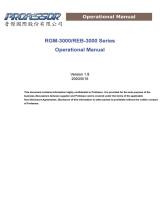
AGL3080 GPS Photo Tracker User Manual V2.2
May 2009 V2.2 AMOD Technology 6
status information) will be valid only for around two hours, they need to be updated regularly. These
information are location-dependent – at two far enough locations the GPS receiver will see different set of
GPS satellites, hence different satellites data. GPS receivers assume the on-hand internal satellites data is
valid and will use it first in searching and tracking satellites. If wrong satellite data is used, the searching will
take a long time or even fail. The GPS Reset function thus can help speed up the position fix operation if the
device was used previously at place(s) far away from the current location or over some time (> two hours)
ago.
Set Up Mode
AGL3080 has 6 logging modes for user to choose from if it's desired. User can configure the tracking
modes in "Set Up Mode".
Entering "Set Up Mode"
At device power off status, hold both "POWER ON/OFF" button and "MARK" button simultaneously for
5 seconds. When you hold both buttons, the three LED will flash 5 times and stop at light on mode. You can
release the buttons when three LED lights are all on.
Setup mode function description
Logging mode setup AGL3080 has 6 logging modes. You can change logging mode by pressing "MARK"
button. For each press of the "MARK", it enters to following logging mode. Pressing "MARK" at "Mode 6"
will bring you back to "Mode 1".
Logging Modes and corresponding LED status are described as below:
LED Status Output Format Minimum
Records Data Capacity
Hours
Mode 1 Memory Full Led ON GGA/GSA/RMC/VTG->1 sec
GSV -> 5 sec 260,000 72 hours
Mode 2 Memory Full Led Flash Only RMC->1 sec 1,040,000 288 hours
Mode 3 GPS Led ON GGA/GSA/RMC/VTG/GSV->5 sec 260,000 360 hours
Mode 4 GPS Led Flash Only RMC->5 sec 1,040,000 1,440 hours
Mode 5 Battery Low Led ON GGA/GSA/RMC/VTG/GSV->10 sec 260,000 720 hours
Mode 6 Battery Low Led Flash Only RMC->10 sec 1,040,000 2,880 hours
Clear Disk Function Hold "MARK" button for 5 seconds to all three LEDs start blink sequentially, then
release the button to clear up the storage space.
Note:
(a) The device would power off during setup mode if you do not press any button after 1 minute.
(b) If system power is low, the battery led will be on and then device will be powered off. At this time, users
have to replace new batteries.






















